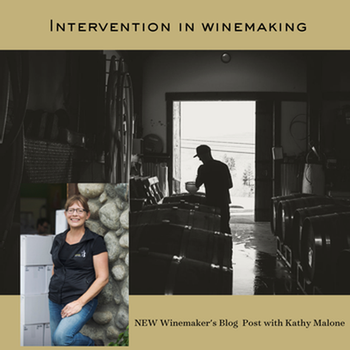The term intervention in winemaking spans a spectrum of practices. In theory, zero intervention would indicate that fruit is left on the vine and no wine is made. Maximum intervention would be…well let’s come back to that.
The grapevine’s primary job, in fact its only desire, is to propagate. It wants to create the condition where the maximum number of well-ripened seeds get spread over the greatest area. To that end, grapevines have evolved to enlist wildlife to help out.
They create acid and green tannins in the fruit which are unpleasant to critters early in the ripening season.
As the season progresses and the seeds become viable, the acidity drops, tannins start to lose bitterness and sugar levels increase, making the fruit quite tasty to birds, bears etc. Add an appealing color change to signal this yumminess and birds tend to eat their fill and fly off—pooping grapeseed far and wide.
So—no intervention would mean leaving the vines to their destiny but would not contribute to the quality of wine or, in fact, its existence. It is apparent that human intervention is necessary to harvest the fruit and create favorable conditions for its conversion to wine. How little intervention can we apply and create a good, or even great wine?
Again—the natural way of things comes into play. Sugar solutions, and grape juice is 20-25% sugar, tend to “kick off”–start to ferment–in non-technical jargon, almost immediately with exposure to the yeast that are ubiquitous on earth.
Other microbes, however, can interfere, creating acetic acid (vinegar) or other unpleasantness. Yeast is comfortable without oxygen, while bacteria require it, so limiting exposure to air will protect juice from spoilage until there is enough alcohol present to inhibit bacteria.
Juice is kept in full vessels, perhaps with gas cover (carbon dioxide or nitrogen) and sulphur can be added to scoop up the oxygen. These are interventions. They are not changing the juice but ensuring it can reach its full potential.
Again and again, throughout the creation of wine, these interventions happen. Do we punch down the cap of red fermentations so that the juice can continue to extract colour and tannin components from the skins? Do we encourage secondary fermentation, converting malic acid to lactic acid so that it doesn’t happen later in the bottle?
Do we put the wine into oak to encourage structuring and softening of tannin components? Do we stir barrels to mix in the lees and add complexity to the palate? All could be considered interventions.
So what is excessive intervention? When I was a kid, my folks quite enjoyed tucking into a glass of a name-brand “Hearty Burgundy”. (It bore no resemblance to the subtle beauty of pinot noir.) This belonged to a class of wines which are specifically made to be consistent, tank to tank, year to year. Always the same, so the customer feels comfortable. I call these “factory” wines. The process is designed to smooth out any variations in fruit quality, ripeness level etc.
To that end, much science is applied and many interventions employed. Vineyard practices are tweaked to produce the maximum yield. Fruit is analysed for every possible parameter and corrections are made to bring it to pre-determined standard levels: sugar, acid, colour compounds, tannins etc. Cellar practices are designed to minimise costs while still complying with standards. Fruit or juice or wine is sourced from wherever is cheapest/easiest/tastes—well—doesn’t suck. Fining agents may be used to remove any unpleasant flavour or colour component.
If the customer likes a sweet red wine but doesn’t want fermentation in the bottle, there’s a chemical for that. Prior to bottling final additions will make up for any deficiencies.
This is clearly not the kind of wine that showcases the gorgeous terroir of the Naramata Bench. We want to apply the appropriate interventions that will bring forth the best qualities of the grapes, not obscure soil or vintage differences, and really convey the sense of place wine should demonstrate. So—yes we do use sulphur so that bacterial spoilage doesn’t rob the juice of its varietal aromas.
We do use carefully selected yeasts which are cultured to respect and enhance flavours of each white wine variety and to the reds after we have allowed indigenous yeast to initiate fermentation, to ensure completion of sugar conversion.
We control the temperature (cool) of the white ferments so that aromatics don’t “boil” off, and of the reds (warm) to achieve full extraction of tannin and colour from skins. We monitor fermentations closely to ensure the yeast is healthy and happy, because unhappy yeast create compounds which mask or destroy aromatics. We keep all wine vessels full to stop the oxidation which robs flavour. White wines are fined with natural clay to remove protein which clouds the wine, and chilled then filtered to remove excess tartaric acid which can form crystals in the wine.
We choose the practices which we feel will protect wine from microbial intervention and allow it to realize its full potential–“just right” intervention.

